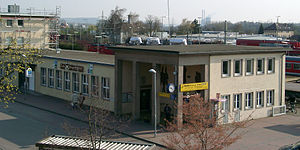Bad Friedrichshall Hauptbahnhof
| Through station | |

Station building from the north
|
|
| Location | Jagstfelder Str. 99, Bad Friedrichshall, Baden-Württemberg Germany |
| Coordinates | 49°13′55″N 9°11′58″E / 49.23194°N 9.19944°ECoordinates: 49°13′55″N 9°11′58″E / 49.23194°N 9.19944°E |
| Line(s) | |
| Platforms | 6 |
| Construction | |
| Architect |
|
| Other information | |
| Station code | 277 |
| DS100 code | TBF |
| IBNR | 8000017 |
| Category | 3 |
| Website | www.bahnhof.de |
| History | |
| Opened | 11 September 1866 |
| Previous names | Bad Friedrichshall-Jagstfeld |
Bad Friedrichshall Hauptbahnhof is a regionally important junction station and a former border station in the city of Bad Friedrichshall in the German state of Baden-Württemberg. The modern Elsenz Valley Railway and Neckar Valley Railway branch from the Franconia Railway here. Until 1993 it was the starting point of the Lower Kocher Valley Railway.
Until 13 December 2014 it was called Bad Friedrichshall-Jagstfeld station.
The Royal Württemberg State Railways (German: Königlich Württembergischen Staats-Eisenbahnen, KWSt.E) opened the station in 1866 on the Neckar Railway (Neckarbahn) and Lower Jagst Railway (Untere Jagstbahn) from Heilbronn to Osterburken in the then independent town of Jagstfeld. This route is now considered part of the Franconia Railway (Frankenbahn). In 1869 the Grand Duchy of Baden State Railway (BadStB) opened the West Fork Railway (Westlichen Gabelbahn, the modern Elsenz Valley Railway) to Meckenheim, connecting to Heidelberg. In 1879, it opened another line to Heidelberg, the Neckar Valley Railway, via Neckarelz and Eberbach. Jagstfeld was a border station with customs facilities.
The station building was located on an island between the tracks of the two countries' railway companies: on the eastern side were the rail facilities for the Württemberg Railways lines to Heilbronn and Stuttgart and to Osterburken and Würzburg. On the western side trains were the facilities of the Baden Railway, serving trains running either on the Neckar line towards Neckarelz and or via a western curve in the northern track field—this layout continues today—on to the Elzenz Valley Railway and running over a bridge over the Neckar and continuing down the valley before turning to the west. Both lines come together again in Neckargemünd.
...
Wikipedia
